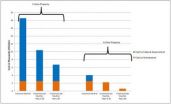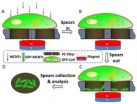(Press-News.org) Philadelphia, PA, July 17, 2014 – A new analysis of data from 1988-2008 has revealed a 40% decrease in the incidence of stroke in Medicare patients 65 years of age and older. This decline is greater than anticipated considering this population's risk factors for stroke, and applies to both ischemic and hemorrhagic strokes. Investigators also found death resulting from stroke declined during the same period. Their findings are published in the July issue of The American Journal of Medicine.
Preventable but deadly, stroke is the fourth leading cause of mortality in the United States, with approximately 795,000 strokes occurring each year. Beyond the impact on patients, treatment and after care place high demands on doctors and health care facilities. With an aging population reaching Medicare age, deconstructing and studying stroke statistics are important for understanding the causes underlying this downward trend, benefiting both patients and providers.
"Shedding light on trends in the burden of stroke among Medicare beneficiaries may provide important information for policy purposes, including describing the past and current scope of the condition, assessing the potential effect of stroke prevention interventions on a national level, and identifying areas where resources can be targeted more specifically and effectively," says lead investigator Margaret C. Fang, MD, MPH, an Associate Professor of Medicine at the University of California San Francisco School of Medicine, who also serves as the Medical Director of the UCSF Anticoagulation Clinic.
The study was constructed to analyze stroke cases over the past two decades, not to investigate causation; however, researchers did find evolving patterns in the risk factors associated with strokes. Although the prevalence of diabetes mellitus increased over time, other risk factors, such as cigarette smoking, measured systolic blood pressure, and total cholesterol values, decreased.
The decline in stroke rates paralleled increasing use of antihypertensive and statin medications and might explain the reduction in stroke rates. "Antihypertensive medications reduce the risk of stroke by approximately 32% and statins by approximately 21%. Stroke rates seem to decrease most sharply after year 1998, approximately when statin use became more prevalent," explains Dr. Fang. "If true, then this illustrates how medical interventions have resulted in significant improvements in health on a population level."
Investigators analyzed occurrence data from a sample of Medicare patients diagnosed as having suffered a stroke. Risk factors such as high blood pressure, diabetes, smoking status, and high lipid levels were gathered from the National Health and Nutrition Examination Survey (NHANES). The Medicare Current Beneficiary Survey was used to determine medication use.
The team identified more than one million stroke events from 1988 to 2008, of which 87.3% were ischemic and 12.7% hemorrhagic strokes. The analysis showed a reduction in ischemic strokes from 927 per 100,000 in 1988 to just 545 per 100,000 in 2008. Hemorrhagic strokes decreased from 112 per 100,000 to 94 per 100,000 over the same time period, primarily among men.
Data indicated that stroke mortality also declined. The risk-adjusted 30-day mortality rate for ischemic strokes fell from 15.9% in 1988 to 12.7% in 2008. For hemorrhagic stroke, the mortality rates declined slightly from 44.7% in 1988 to 39.3% in 2008.
Dr. Fang notes that "Our analysis confirms the continuing and devastating effect of hemorrhagic stroke, but was unable to assess for casual factors influencing mortality rates; relatively few interventions have been shown to reduce stroke-related mortality. Timely administration of intravenous thrombolytics is associated with more favorable outcomes from ischemic stroke, but has not been shown to have significant effects on mortality. In addition, the rate of thrombolytic administration continues to be low in the United States."
INFORMATION:
Incidence of stroke in the elderly has dropped by 40 percent over the last 20 years
Good news for an aging population: Rates declined for ischemic and hemorrhagic stroke and mortality in both men and women 65 years and older, reports The American Journal of Medicine
2014-07-17
ELSE PRESS RELEASES FROM THIS DATE:
NYU Langone investigators to present new research at 2014 Alzheimer's Association International Conference
2014-07-17
(New York, NY, July 12, 2014) - Researchers from the Center for Cognitive Neurology (CCN) at NYU Langone Medical Center, NYU School of Medicine, and the Nathan S. Kline Research Institute will present new findings at the 2014 Alzheimer's Association International Conference in Copenhagen, Denmark, July 12 – 17, 2014.
The Center for Cognitive Neurology is a multidisciplinary, integrated center devoted to research, clinical care and clinical advances toward the treatment and cure of neurological diseases affecting cognition -- focused on memory, language, attention, auditory, ...
The rate at which groundwater reservoirs are being depleted is increasing
2014-07-17
FRANKFURT.In what parts of the world and to what degree have groundwater reservoirs been depleted over the past 50 years? The Frankfurt hydrologist Prof. Petra Döll has been researching this using the global water model WaterGAP. She has arrived at the most reliable estimate to date by taking into consideration processes which are important in dry regions of the world. The values calculated were compared with monitoring data from many different wells and data from the GRACE satellites. These satellites measure changes in the Earth's gravity field. Döll has come to the conclusion ...
What are the risks of post-traumatic stress disorder after an accident?
2014-07-17
This news release is available in French. Many patients continue to suffer from symptoms (headaches, pain) several months after an accident, which can pose a real handicap to their lives. The team of Emmanuel Lagarde, research director at Inserm's Research Centre for Epidemiology and Biostatistics (Inserm/University of Bordeaux) has studied the subsequent development of 1,300 people who were admitted to A&R between 2007 and 2009 for trauma. The researchers demonstrate that it is possible to identify people who will develop post-traumatic stress disorder, which generally ...
Danish DNA could be key to happiness
2014-07-17
Genetics could be the key to explaining nation's levels of happiness, according to research from the University of Warwick.
Economists at the University's Centre for Competitive Advantage in the Global Economy (CAGE) have looked at why certain countries top the world happiness rankings. In particular they have found the closer a nation is to the genetic makeup of Denmark, the happier that country is. The research could help to solve the puzzle of why a country like Denmark so regularly tops the world happiness rankings.
Dr Eugenio Proto and Professor Andrew Oswald ...
Potential new therapy with brain-on-a-chip axonal strain injury model
2014-07-17
University of Houston researchers have devised a new method for extracting molecules from live cells without disrupting cell development, work that could provide new avenues for the diagnosis of cancer and other diseases.
The researchers used magnetized carbon nanotubes to extract biomolecules from live cells, allowing them to retrieve molecular information without killing the individual cells. A description of the work appears this week in the Proceedings of the National Academy of Sciences.
Most current methods of identifying intracellular information result ...
Is the US National Flood Insurance Program affordable?
2014-07-17
There is often tension between setting insurance premiums that reflect risk and dealing with equity/affordability issues. The National Flood Insurance Program (NFIP) in the United States recently moved toward elimination of certain premium discounts, but this raised issues with respect to the affordability of coverage for homeowners in flood-prone areas. Ultimately, Congress reversed course and reinstated discounted rates for certain classes of policyholders.
Carolyn Kousky (Resources for the Future, USA) and Howard Kunreuther's (The Wharton School, University of Pennsylvania, ...
Plasmon-enhanced Polarization-selective filter
2014-07-17
As we all know, some optical devices can only work with a certain incident polarization direction. In this case, a polarizer is necessary to shift the polarization direction of linearly polarized light. A common polarizer is also called half-wave plate, which constructed out of a birefringent material (such as quartz or mica). The behaviour of a half-wave plate depends on the thickness of the crystal, the wavelength of light. Considering the fabrication of crystal, a half-wave plate is difficulty to integrate on circuits. Then what kind of polarizer can be integrated on ...
Do urban casinos increase local crime? Not in this case study
2014-07-17
Philadelphia's SugarHouse Casino opened its doors in September 2010 after years of protests from community members who feared that the casino would lead to an increase in neighborhood crime. However, a new study by researchers at Drexel University and Temple University reveals that these concerns were unfounded.
The study, which used geolocated crime data to examine changes in crime volume in the immediate neighborhood of the casino since its opening, found that crime rates in the Fishtown neighborhood of Philadelphia were largely unaffected by the introduction of the ...
University of Houston researchers create new method to draw molecules from live cells
2014-07-17
University of Houston researchers have devised a new method for extracting molecules from live cells without disrupting cell development, work that could provide new avenues for the diagnosis of cancer and other diseases.
The researchers used magnetized carbon nanotubes to extract biomolecules from live cells, allowing them to retrieve molecular information without killing the individual cells. A description of the work appears this week in the Proceedings of the National Academy of Sciences.
Most current methods of identifying intracellular information result ...
Study: Hour-long home coaching decreases re-admission, costs for Medicare patients
2014-07-17
CLEVELAND -- A new study in Journal of General Internal Medicine reports that an hour-long educational coaching session and two or three follow-up phone calls after a hospital stay reduced re-admission odds by 39 percent among Medicare patients. The study also found that the average cost of care was reduced by $3,700 per patient for those patients who received the education session versus those who did not.
This study is the first to report on a more comprehensive picture of healthcare use in the six months following the patient-centered coaching, called Care Transitions ...
LAST 30 PRESS RELEASES:
Global psychiatry mourns Professor Dan Stein, visionary who transformed mental health science across Africa and beyond
KIST develops eco-friendly palladium recovery technology to safeguard resource security
Statins significantly reduce mortality risk for adults with diabetes, regardless of cardiovascular risk
Brain immune cells may drive more damage in females than males with Alzheimer’s
Evidence-based recommendations empower clinicians to manage epilepsy in pregnancy
Fungus turns bark beetles’ defenses against them
There are new antivirals being tested for herpesviruses. Scientists now know how they work
CDI scientist, colleagues author review of global burden of fungus Candida auris
How does stroke influence speech comprehension?
B cells transiently unlock their plasticity, risking lymphoma development
Advanced AI dodel predicts spoken language outcomes in deaf children after cochlear implants
Multimodal imaging-based cerebral blood flow prediction model development in simulated microgravity
Accelerated streaming subgraph matching framework is faster, more robust, and scalable
Gestational diabetes rose every year in the US since 2016
OHSU researchers find breast cancer drug boosts leukemia treatment
Fear and medical misinformation regarding risk of progression or recurrence among patients with breast cancer
Glucagonlike peptide-1 receptor agonists and asthma risk in adolescents with obesity
Reviving dormant immunity: Millimeter waves reprogram the immunosuppressive microenvironment to potentiate immunotherapy without obvious side effects
Safety decision-making for autonomous vehicles integrating passenger physiological states by fNIRS
Fires could emit more air pollution than previously estimated
A new way to map how cells choose their fate
Numbers in our sights affect how we perceive space
SIMJ announces global collaborative book project in commemoration of its 75th anniversary
Air pollution exposure and birth weight
Obstructive sleep apnea risk and mental health conditions among older adults
How talking slows eye movements behind the wheel
The Ceramic Society of Japan’s Oxoate Ceramics Research Association launches new international book project
Heart-brain connection: international study reveals the role of the vagus nerve in keeping the heart young
Researchers identify Rb1 as a predictive biomarker for a new therapeutic strategy in some breast cancers
Survey reveals ethical gaps slowing AI adoption in pediatric surgery
[Press-News.org] Incidence of stroke in the elderly has dropped by 40 percent over the last 20 yearsGood news for an aging population: Rates declined for ischemic and hemorrhagic stroke and mortality in both men and women 65 years and older, reports The American Journal of Medicine




